Creative Processes Kitty Fabry AD120 Creative Problem Solving. A living body and document of creative work.
Don't wanna be here? Send us removal request.
Photo




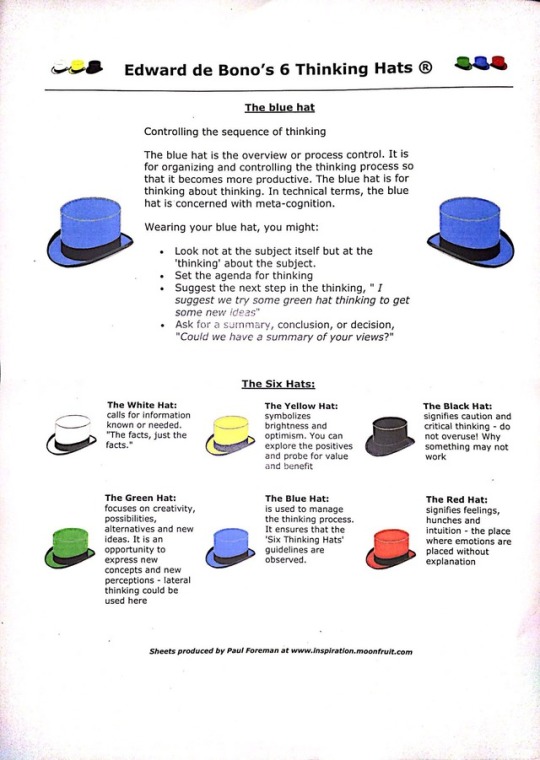


EDWARD BONO’S SIX THINKING HATS
We used Edward Bono’s Six Thinking Hats in a recent workshop discussing Brief 2 in teams.
The Six Thinking Hats Bono has created are devised out of six catagories and ways of thinking. The metaphorical ‘hats’ are worn to create a system were each point of interest in the discussion is identified. It is to increase the productivity and allows the team to change and manage the expression of opinions. Each ‘hat’ signifies a different vital part of the agenda and focuses the conversation on key topics relating to that point.
Using the Six Thinking Hats was a really valuable experience and has managed our teams thoughts on Brief 2 very effectively. As we review and go into more depth about the ideas we discussed from our visual thinking session I plan to wear the ‘Blue Hat’ as it were about ensure that the Six Thinking Hats are being used again correctly.
Creative Minds.org
http://creatingminds.org/tools/six_hats.htm
References:
Foreman, P. (n.d.). Edward Bono's 6 Thinking Hats. www.inspiration.moonfruit.com.
Creatingminds.org. (2015). Six Thinking Hats. [online] Available at: http://creatingminds.org/tools/six_hats.htm [Accessed 19 Nov. 2018].
0 notes
Photo

RANDOM STIMULUS, WORDS & ASSOCIATIONS
The method is to write down the words that come to mind after being shown an image of random stimulus.
Our image for a workshop on our Brief 2 ideas was a collection of LEGO pieces.
I resulted in a range of words, some better then others in accordance to the problem with the High St. For instance I came up with words such as ‘experience’, ‘accessible’ , ‘interactive’ and ‘learning’.

This second page, titled “New directions” was when we were prompted to make connections between our Brief 2 and the words/stimulus we had been working on. It opened up to numerous ideas, steming and themed from the word that gave our team ideas for especially how our creative intervention should have an impact on people.
A lot of what we came up with related back to ideas that we had had previously for Brief 2. This may seem like we were going back around in circles but it actually was really useful in reminding us to make these solutions for instance ‘engaging’ and ‘accessible’ etc. It was a valuable process as the words saw connections and therefore made us see some new ones as well.

In the end we made some more “How Might We” question frames, and all of them worked towards what we were already aiming towards in our team.
If we ever feel stuck in our group project then I certainly plan to use this random stimuli method again. The only thing I would comment on is that I think we found it hard to move away from the ideas that we had had previously from our original challenge maps/frames before. In hindsight how I would like to use this method again would be through implementing it at the beginning of a brief, especially if it is felt that the task is in need of a very ‘out-there’ solution. This may be for quite complex and bland tasks, so again I plan to use the random stimuli method especially in these situations.
0 notes
Photo

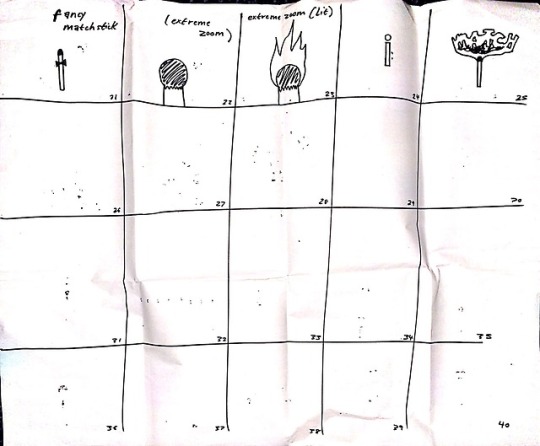
VISUAL THINKING
In a workshop we conducted we were all given a matchbox and asked to draw it in 40 different ways. The task was to emphasise the fact that sketching is important for idea generation and has value, nevermind the quality and talent of the drawing and the drawer.
Although I was not able to finish 40 sketches I certainly understood that the benefit of drawing was that it focused the mind and puts the person into a type of ‘mind palace’ or focused thinking space. What was so game-changing about the experience was how the information and thoughts I was having seemed to condense on the page. Even though the task of drawing a matchstick in different ways was quite simple to begin with, still the complex bulk of my ideas was localised in a manageable and much more memorable (for later reference) visual form.
We briefly discussed our drawings and outcomes, which evidenced another benefit of sketching and visual thinking, that drawings are very social things. A significant part of art is that, no matter how rough it draws people into discussion as they feel like the material and the idea behind it is much more approachable. If they like people can even criticise or suggest changes to the drawing, and therefore open up discussion about changes to the idea as well.
My plan is to utilize visual thinking and sketching much more within my own processes. I plan to forget about any concerns I may have with my own skill of drawing and focus on how it has been evidenced here as a worthwhile experience, and I will advice the same to anyone I am working with to re-create that same open and social enviroment of discussion. Particurally within Brief 2 I imagine drawing multiple thumbnails will be useful. Possibly not 40 each but plan instead to create 10 sketches of our ideas per person and then discuss.
0 notes
Text
POTENTIAL RESEARCH METHODS
Research methods as a team we could apply to Brief 2...
Methods:
Photo Narrative / Photo Study
Interview an “extreme user” - *the average Joe will lend much less interesting insights - the shopkeeper how works on the High St 12 hrs a day, the older lady who never leaves the house and shops online
Collage
Personas: (Use interviews to get info. you need to fill out an Persona)
Cultural Probe
Bodystorming
Diary Study. Get a team of 5 users together and ask them to make a diary of their experiences (think ‘petography’). Remember to give them prompts. *Make it interactive and fun, easy so that the users can easily record their data
Vox Pop interviews (quick, unstructured interviews, letting the audience guide the interview)
Collect objects/ products / artifacts (Everything We Touch Zuccotti, 2015)
Behavioural mapping/ Fly on the wall / Shadowing (mapping peoples routes around where they walk, where do they go?)
Love Letter & Breakup Letter - rich and inspired method of getting insight. Users speach in a more emotive way
Stakeholder Maps/Empathy map of users - who matters within your circle, who feels what, use interviews to get info
Graffiti Walls - capture informal opinions directly in public enviroments
Walk in your audience’s shoes:
*what it gains you...
Talking to stakeholders in their worlds gives you very personal insights
You can identify user needs and insights
You move beyond preconceptions
Find energy and innovative directions
You can find what is not feasible
*it can take a long time to get meaningful material, which is something should be considering for all research methods we undertake
Making this list inspired by the lecture we had on research methods is a genuinely useful resource to refer back to if our team either feels stuck over ideas for the ways we could conduct research and gather information. Similar to Bob Gill’s idea that “Unless you can begin with an interesting problem, it is unlikely that you will end up with an interesting solution” - it would be hard to recieve interesting information unless we have an interesting method of researching. The list works to inspire us over the diverse range of research mehtods we could us.
My plan is to have this list at the ready when discussing moving forward with our ideas as a group, and take action using these as a guide of reference.
0 notes
Photo
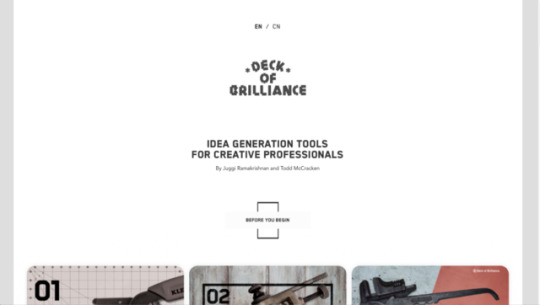
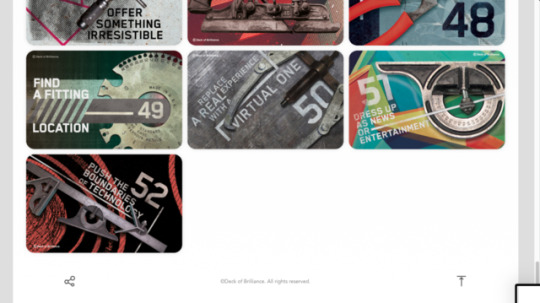
*watch my scroll through the ‘deck’
“The Deck of Brilliance can help you face that blank page and looming deadline with a bit more confidence.It gives you 52 tools for working up ideas in short periods of time.“
“The Deck of Brilliance is as close as we will ever get to answer the eternal question: How do you come up with ideas?” - Anselmo Ramos, Chief Creative Officer & Founder, DAVID
- We were suggested this website in a copywriting lecture. I since went on to the website, ‘shuffling the deck’ I am excited to use this information and hopefully reference individual cards and techiniques I learn’t. This information will be handy through my creative process, so far I am really drawn towards these cards as they connect well with what we have been beginning to learn as well as what we are doing for Assignment 2...
05. LET THE SOLUTION CREATE A NEW PROBLEM - *reminds me of Bob Gill’s “The problem is the problem” theory from Graphic Design as a Second Language.
12. TAKE THE AUDIENCE BACKSTAGE - “Show your viewers how your product is made. Show them what makes it special.“ - for Assignment 2, show the audience what they are missing out on from the High St and the potential High St experience
33. APPLY SOCIAL PRESSURE - dips into what our team were suggesting with the Anti experience posters / You could of… concept for Assignment 2. The idea of implementing some slight feelings of guilt, and missed oppoturnity. “The pressure you apply can also be encouraging”
34. STAGE A SPECTACLE - ultimately what we are trying to achieve within Assignment 2 “get on the news and create some buzz“ “generate content that will get passed around on social media”. I think both those ideals fit very well with the nature and purpose of ‘creative conventions’ and ‘passion projects’ in general
40. INVITE PARTICIPATION - “When your viewers play an active role in your ad, they are more likely to help spread the message.“ - another feature/purpose of creative conventions and passion projects, spreading the message mostly through human interaction, engagement and then later on, hopefully through social media to broaden the impact and power of the scheme
References:
Ramakrishnan, J. and McCracken, T. (n.d.). Home - Deck of Brilliance. [online] Deck of Brilliance. Available at: http://deckofbrilliance.com [Accessed 1 Nov. 2018].
0 notes
Video
youtube
Understanding people, customers, audiences, users...
*Sticky, tricky to open door in the Vox office displays how different people tackle problems
‘The Normon Door’
- speaks to Don Normon, Professor of psychology, cognitive science, computer science. Vice president of advanced techonology at Apple. Originally published in 1988 Normon wrote The Design of Everyday Things *(which is actually a book that I read during my Art Foundation year - a fantastic book for when I was researching the power of persuasive design and how design influences people).
The original title was: The Psychology of Everyday Things
{ “psychology /
1. the scientific study of the way the human mind works and how it influences behaviour, or the influence of a particular person's character on their behaviour” }
- as designers its important to understand how our work is going to interact and again INFLUENCE people.
If you continually get a door wrong is it your fault? “No” says Don Normon.
A ‘Normon Door’
“A door that tells you the opposite of what you're supposed to do, or requires a sign to tell you what to do. These doors are very frustrating and can be mistaken many times.”
- if its designed well people will know when to ‘push’ or to ‘pull’ immediately - - -
One of the basic principles of design in the video Normon calls “discoverability” - “The ability to discover what operations one can do” (when discoverability is not there you don’t know how to use something)
Another basic principle of design suggested here is “feedback” - “A signal to what happened” (sometimes theres no feedback and you don’t even know what happened)
- Discoverability and feedback form the basis of how designers and engineers work today. IT IS MORE COMMONLY KNOWN AS
Human-Centered Design
*iterative this research focus “goes around in a circle” as “quite often we are wrong at first”...
we go out and be observe people doing a task, and from that we have some ideas on what we should propose to do
Then it goes onto prototyping
and testing
*a reminder of the types of research we should implement for Brief 2 - as our creative challenge for the High St involves people we need to be ‘human-centered’ and respond to how the people act/react.
I watched this video by Vox after it was adviced to us in a lecture. “Understanding people, customers, audiences, users...” truly did just that as the video informed the listener about the idea of ‘human-centered design’ and ultimately the importance of “discoverability and feedback”. Its information that as I suggested is relevant to our Brief 2. It was a very valuable video to watch, particurally as it interviewed Don Normon, who I consider to be a respectable proffesional voice who has plently of experience in the field.
I will apply the knowledge that I gained from watching the video by keeping the ideas on human-centered design in the front of my thoughts as we do our research for Brief 2 and move forward with our ideas. “Understanding people” is critcal to creating an effective creative intervention for Brief 2, as helping the struggling High St depends on getting more people to come there in an appealing, positive and engaging way.
References:
Vox (2016). It's not you. Bad doors are everywhere.. [video] Available at: https://www.youtube.com/watch?v=yY96hTb8WgI [Accessed 27 Oct. 2018].
Dictionary, P. (n.d.). PSYCHOLOGY | meaning in the Cambridge English Dictionary. [online] Dictionary.cambridge.org. Available at: https://dictionary.cambridge.org/dictionary/english/psychology [Accessed 27 Oct. 2018].
Urban Dictionary. (2016). Urban Dictionary: Norman Door. [online] Available at: https://www.urbandictionary.com/define.php?term=Norman%20Door [Accessed 27 Oct. 2018].
0 notes
Photo
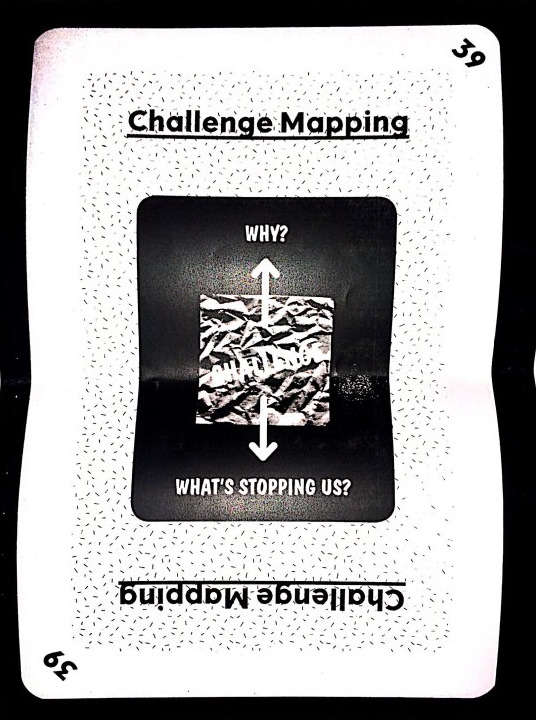
CHALLENGE MAPPING
“to identify interrelated challenges in order to decide which problem to focus on”. “Projects rarely face just one challange” “problems interrelate” “Determining how they differ and relate to each other is a great help when deciding where to start”.
“Start out by framing your problem as a challenge” “place it at the centre”
“Next, perform a ‘Why?’ and ‘What’s stopping us?’“ “(asking the question ‘Why’ will transport you to a higher-level challenge”)(”What is stopping us? you move towards a lower-level challenge”)
“Each new challenge is written” “and placed below or beyond the previous challenge”
“you will begin to see a map of interrelated challenges, which will help you decide which challenge(s) you want to work with”
0 notes
Photo
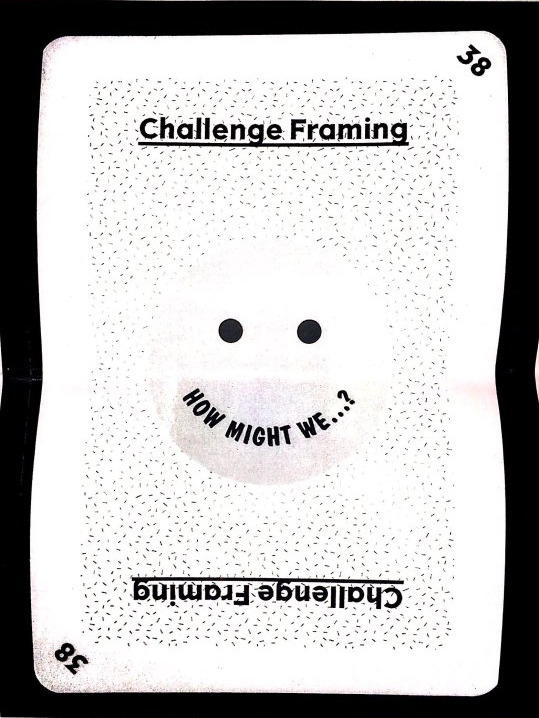
CHALLENGE FRAMING
*challenge framing was something we mentioned while discussing Brief 2. I enjoyed this positive way of approaching the problem, its a great example of how re-wording a brief can make you approach the task completely differently.
“means reinterpreting problems as challenges in order to help focus and move projects forward in a proactive and positive way”. “frame problems as interesting challenges” “If you see challenges as difficult problems to overcome energy seeps out of the project and problems become roadblocks”.”reframe problems as questions” “How might we...?” “once you have identified and formulated the challenge, problem solving becomes a lot easier”.
“Start out by listing different problems” (”you might think about problems in relation to consumers” e.g ”they do not recycle toothbrushes”,”buisness model” e.g “obsolescence factor” “materials used” e.g “composities, difficult to take apart and recycle”, “perceptions of your own company” e.g “lacking necessary awareness” etc.
“Once you have listed the aspects, turn them into challenges” “’How might we...?’”
“Generate ideas for several challenges before deciding which one(s)”
0 notes
Photo
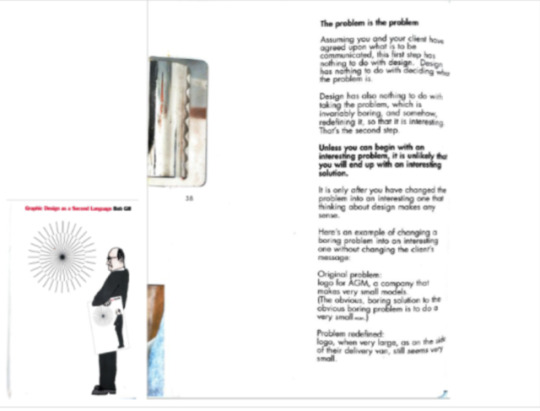
12.10.18
BOB GILL / / Falling in love with the PROBLEM rather then the SOLUTION / / TURNING THE CREATIVE CHALLENGE INTO A POSITIVE
Bob Gill, American illustrator and writer of a book reccommended to us within the seminar, Graphic Design as a Second Language suggested that “The problem is the problem”. The book and Gill’s approach to the ‘creative challenge’ in general sounds really fascinating, so I would like to try and get my hands on this book to read in full. Some of the points that I went back to read on a particular chapter in his book and found extremely beneficial to my own thoughts of creative problem solving were...
“Design has nothing to do with what the problem is”
“Unless you can begin with an interesting problem, it is unlikely that you will end up with an interesting solution” - “It is only after you have changed a boring problem into an interesting one without changing the clients message”
“Redefining it” “That’s the second step”

In the seminar we followed a lot of Bob Gill’s ideas of thinking positively and turning problems into more stimulating questions.
I chose to take this slide from the presentation as is perfectly summarizes the type of new method we were learning. A technique of tackling the issue, turning a creative problem into a positive. I found it really engaging how simply re-wording the task/brief can completely alter your way of thinking and conjure up more solutions and answers effeciently.
This will be a particuraly useful way of breaking up the challenge for Brief 2, and forming a more “interesting problem” and therefore a more “interesting solution” as Gill proposes. It will also create a challenge for our team that is much more engaging and motivating.
References:
En.wikipedia.org. (n.d.). Bob Gill (artist). [online] Available at: https://en.wikipedia.org/wiki/Bob_Gill_(artist) [Accessed 12 Oct. 2018].
Branch, J. (2018). Wk3 Workshop Intro + Brief 2 launch. [pdf] Available at: https://learningspace.falmouth.ac.uk/course/view.php?id=2911 [Accessed 12 Oct. 2018].
0 notes
Video
youtube
CREATIVITY AND PLAY / / TIM BROWN
We fear the judgement of our peers - this is what restrains us from creativity. Adults letting themselves lose freedom, because we fear failure
Industry proffesionals understand the importance of visual stimuli in the workplace. Its present in such places as Google, Pixar, all studios have fun bits of ‘kit’ - “symbols” of creativity and play. “We use it in a pretty pragmatic way to be honest”-“We think it lets us do our job better” (because they know its a part of the creative practice to think inventively in this way and let go)
Engage with open possibilites - asking “what can I do with it” not just “what is it”
Exploratory play - the fear of not being original - just go for it, exhaust all of the options thinking laterally (its a form of play even when they are not all unique)
Coming from exploratory play - forgetting adult behaviours and stopping these habits and limitations getting in the way of our ideas
Rules to be liberated from - creative constraints - “we can get much more creative outcomes when everybody does play by the rules”
Experimentation - construction play, a powerful way to learn, learning by doing - “thinking with your hands” - making multiple low resolution prototypes quickly, advancing your thinking by bringing something into the real world physically --
The loss of what facilitates our playful nature and thinking, being able to communicate again through prototypes and being able to test our ideas with consumers in a better way then words
Role play is also an effective way of acting out any flaws in your design, we can be dismissive towards these strategies because of a fear of embrassment and a scepticity that this interaction is invalid - we should take advantage of our knowledge of the human condition an social situations as adults and use these to more easily point out authenticity or whether these scenarios/designs etc would not work
Inject ourselves into an experience - to understand what it may feel like (role play again can be really effective). Projecting yourself, gaining a consumer perspective, to create empathy is valuable. Insights into the experience - a willingness to play
Role play as a good tool for prototypes as well as empathy for designers
Play is not anarchy, play has rules - following these types of creative constraints is what leads to a productive outcome
Rules when to play - to be able to transition in and out of play, and how to go through these experiences. Generative mode when we are exploring many ideas vs looking for a solution to develop. Divergance and Convergance
Divergent mode should have playfulness while convergent mode is making the decisions and being serious. To be able to move between these modes is therfore important in order to reach a resolution
You can be a serious, proffesional adult and at times be playful. “It is not an ‘either’,‘or’ its an and”
We need trust to play and we need trust to be creative.
Exploration: Go for quantity
Building: Think with your hands
Role play: Act it out
References:
TED (2008). Tim Brown: Tales of creativity and play. [video] Available at: https://www.youtube.com/watch?v=RjwUn-aA0VY [Accessed 4 Oct. 2018].
0 notes
Video
youtube
STEAL LIKE AN ARTIST / / AUSTIN KLEON
Be constantly active, imaginative, working towards a non-existant project or goal
“You respect but I love” - paying homage to the things that mean something to you
An artist is a collector - an ideas hoarder
*reading, reading the newspaper as great way to collect ideas - particuraly of the human experience
Connecting and making patterns, a mash-up of one or two previous ideas (that is what art is)
The fact is that everyone gets their ideas from other sources of inspiration - we are all stealing in a un-ending cycle of unoriginality
“Instead of getting discouraged I moved on” because nothing is original, all creative work is’nt
The genealogy of ideas - we can pick the books we read, the people we speak to, the movies we see, the enviroments we live in - we are a mash-up ourselves of what we let into our lives
A creative kleptomaniac - but stealing the things that mean something to you and that you can use in your work - “trying to expose yourself to the best things humans have done, and bring those things into what you are doing”
“Good artists copy, great artists steal” - act shamelessly when stealing ideas
Ask yourself is it worth stealing (YES/NO) and move onto the next thing - take only what you can use and develop from there
Imitation is not flattery. Transformation is flattery
Take a nugget of what resonates with you, the people you bump into...take it back to your desk and to your own thoughts and ideas and transform it into something completely ‘new’
References:
TEDx Talks (2012). Steal Like An Artist: Austin Kleon at TEDxKC. [video] Available at: https://www.youtube.com/watch?v=oww7oB9rjgw [Accessed 4 Oct. 2018].
0 notes